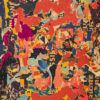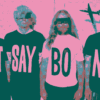Cut Me Up‘s founder and editor, Andrea Burgay, commissioned our own Max-o-matic to curate the magazine’s 4th issue. When finished, they crossed emails with questions and answers about the process, CMU’s philosophy and collage as an art form. Here’s the emailed dialogue:
Max-o-matic : Which qualities do you look for when choosing people to co-curate a CMU issue along with you?
Andrea Burgay: In considering potential curators for Cut Me Up, I look for curators and artists that are deeply engaged with collage and have contributed to an ongoing discussion about what collage as an art form can do and what potentials it has that are yet untapped.
An awareness of the history of collage is essential to understanding what possibilities are currently overlooked. I saw Issue 3: Tabula Rasa curator Todd Bartel present his theories on “Uncollage” at Kolaj Fest in 2018. I had just released Cut Me Up Issue 1. His presentation shared such a wide breadth and depth of knowledge about collage, and conveyed such enthusiasm, that I was sure he would be a perfect fit to curate an issue. I had no idea what concept he would propose, but invited him to curate almost immediately after introducing myself.
Involvement with collage naturally leads each curator to have specific perspectives on what might be missing in the current landscape of work being shown and produced, and ask questions in their call that encourage consideration of new points of view: What techniques are frequently unused (or overused)? How can collage processes—erasure, layering, carefully juxtaposing clean-cut images—become metaphors for concepts to be explored? How do the media and materials that are used shape the meaning of a collage work? How can collage address the deeply personal and/or globally meaningful problems of our times?
I’m careful to invite curators who are excited and inspired by the concept of Cut Me Up, and that are open and interested in collaborating throughout the process. The entire commitment for a curator, from pitching their initial call, to seeing the final magazine in print, is about 9 months. Throughout the process I love the seeing what each curator comes up with and helping shape their ideas to the format of Cut Me Up, considering what has seemed most engaging to our audience throughout the past issues.
I also ask collaborators to present something personal in their call, relate their ideas to their own work in some way, which often happens naturally. The nature of Cut Me Up asks all involved to offer something personal as raw material, as a source of inspiration, and as a point of connection to others. Just as all the participating artists offer up their artwork for others to cut up and transform, the curators are asked to offer the ideas that most inspire them or their work for others to consider and work through.
Max-o-matic: Why me?
Andrea Burgay: I’m a huge fan of your work and have followed it for quite some time, but what highlighted your potential as a curator is your work on The Weird Show. I’ve followed the blog for years and learned about many amazing contemporary collage artists from around the world. In fact, it might have been one of the first sources I found that presented such a wide array of work all under the umbrella of collage—from artists who work small-scale to sculptors, assemblage and installation artists. I knew from the artists that you chose to exhibit, your questions and your writing, that your view of collage embraced an awareness of materials, scale, and environment, and took issue with some of the more banal work being overproduced and taking up a lot of space in the collage world.
From your previous interview with me about Cut Me Up, I also knew that you appreciated the project and would have an awareness of the possibilities that you could unleash with your issue.

Max-o-matic: Do the approaches proposed by different curators meant having really diverse visual outcomes? Or is there a stronger thing that’s natural to collage that makes the different issues somehow similar in style?
Andrea Burgay: Each issue of Cut Me Up is essentially a curated exhibition in book form, shaped both by the overall concept of the project, and the specific eye and mind of the curator.
One of our missions is to show the breadth of approaches and techniques that can be used to manipulate and transform materials. This often leads to showing work that might take a painterly approach or utilize sculpture or photography is some way. We are less interested in works that juxtapose images to create a sort of surreal or humorous photographic illusion. This mission, along with the repetition of imagery from issue to issue, definitely unifies them all visually in some way.
Beyond those tenets, the curatorial calls by each artist greatly shape the color palette and design sensibility of each issue. Issue 3 featured erasure, and asked for 1/3 of each page to be left blank. Your call for Issue 4 asked artists to use contemporary media and primary colors. These aspects of each call render each issue singular and visually unified in and of itself.
Andrea Burgay: Why did you want to work on Cut Me Up?
Max-o-matic: Cut Me Up is in my opinion one of the most interesting independent publications out there. Its concept is really inspiring and playful at the same time. It made me think a lot of collage and art itself. Source material is something that greatly defines our work with collage, and the idea of using collage to make new artworks is as simple as revolutionary.
I also love the idea of each issue having a different approach / theme and set of rules for submissions. It’s a beautiful way to propose to artists a playground to experiment, reflect upon their work and make new pieces influenced by other artists and curator’s ideas.
Max-o-matic: What influenced the theme for your call?
Andrea Burgay: My way into collage, as happened with many artists, was via Dada. I have always been amazed by their radical vision and striking approach to art. I always felt that Dada’s critique of society and culture was way more relevant than how cool the collages looked. Using trash and newspaper imagery at that time was revolutionary in a way that is just unthinkable nowadays. It was political in a very brave and bold way. More than 100 years later, my feeling is that all of the political edge that shaped Dada was downplayed by its aesthetic in such a way that critique was banished and replaced by nostalgia.
On the other side, a more practical one, I always think about why collage artists tend to use vintage imagery when making collage. What makes a Life magazine the standard source material for all of us working with this media? Why can’t we use, as Dada did, our contemporary stuff to try to talk about all the issues that are happening right now? What happens when Life Magazine is replaced with Gucci ads, memes, Netflix screen captures, Instagram posts, emojis, fast food packaging, etc.? Can we swap nostalgia for something related to our contemporary cultural landscape? What happens if we add a bit of political awareness into the mix? Can we focus on Dada’s initial concept instead of their style / aesthetics?
All of these thoughts also come up in my own work (which uses a lot of source images from the past), which was the starting point for the theme of the call. Of course I’m aware that using source material gathered from everyday life won’t make new pieces political and meaningful. But at least it was a nice chance to put out the idea and see if it made anyone think about this.
The idea to start thinking about collage as a way of approaching relevant issues instead of replicating in a shallow way what has been done in the past was what shaped the notion of “Turning Point”. What if this issue of Cut Me Up is the Turning Point for addressing collage as something new that captures Dada’s spirit, but updates it to our contemporary challenges? I know that changing the course of collage is not a realistic goal for a single issue of CMU, but anyway it was fun to imagine.

Andrea Burgay: Did your ideas relate to your own work in any way? To your work with the Weird Show?
Max-o-matic: Of course! I do think about this all the time. What issues I’m addressing as an artist and how I manage to communicate them is something that has been always there for me. And as my works sometimes tend to be quite abstract, this is something that I think about a lot.
Regarding The Weird Show, one of my main concerns that I try to approach is to think about what collage is and what it can be. Defining and redefining collage as an artistic practice is one of the things that moves this project. So having the chance to take part in a project such as Cut Me Up is a really great way to make people think about this.
Andrea Burgay: How did it feel to see the artists responses to your call?
Max-o-matic: It felt awesome! The work looked great and there were lots of people talking about relevant issues through their artworks. Amazing! Also, I did get some feedback from artists that submitted their work telling me that the set of rules that we defined made them approach their work in a new way and that it has been a very interesting situation for them. Can’t ask for more.
Andrea Burgay: How does this issue relate to a broader view of collage as an art form?
Max-o-matic: Collage as it was conceived 100 years ago is already dead as an art form. It has a place in museums, but it doesn’t have a role in contemporary art. Collage is not an aesthetic or a style, but a technique that needs to be able to help artists connect with issues that are relevant nowadays. The relevance of collage as an art form in my opinion is directly related to this shift. We need to adapt collage to the 21st century’s cultural and social landscape. We need to update it to keep it alive.
Find out more about Cut Me Up magazine here: www.cutmeupmagazine.com









